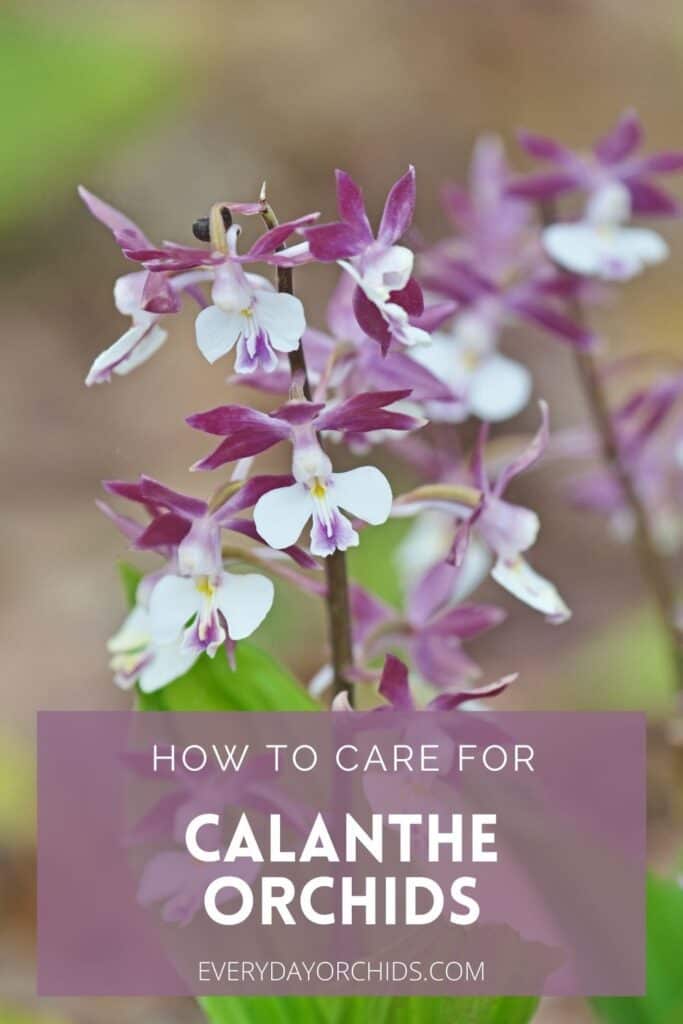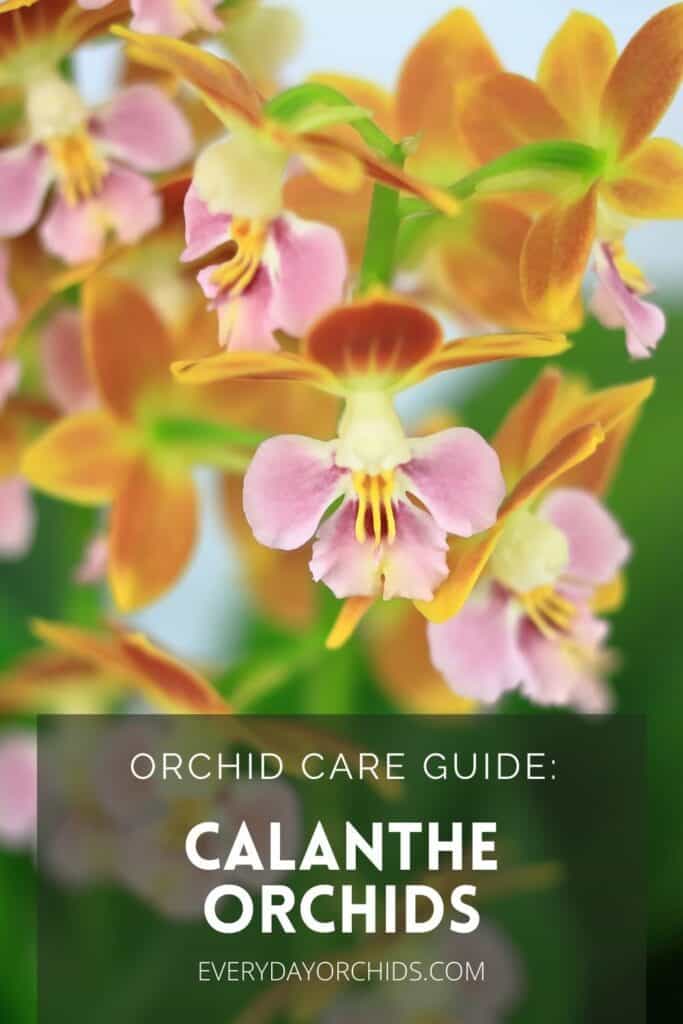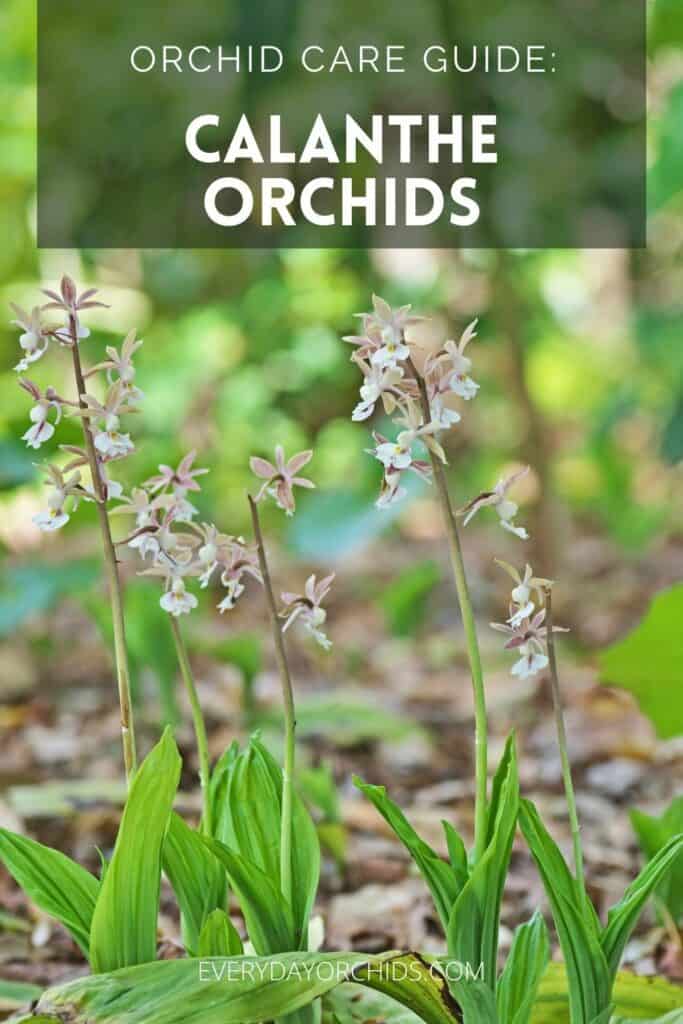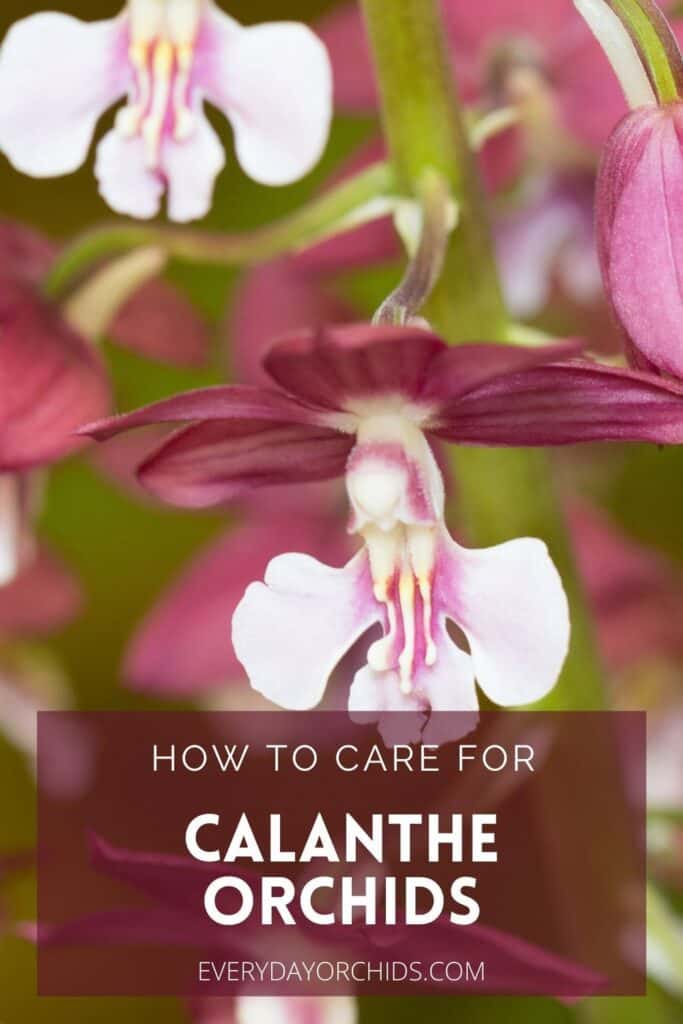Calanthe orchids are a type of terrestrial orchid that is perfect for outdoor gardens and garden beds. These orchids produce clusters of colorful blooms in abundance. Calanthe orchids are relatively easy to care for, but there are some things you should know if you are new to caring for this particular species.
Calanthe orchids do best in partial shade conditions, with 50% humidity levels year-round. They need regular watering and fertilization during the growth season. Calanthe orchids can tolerate mild climates with temperatures ranging from 55 to 85 degrees Fahrenheit, but can survive outdoors year-round down to Zone 6b with proper mulching and protection. These orchids can be propagated via pseudobulb division.
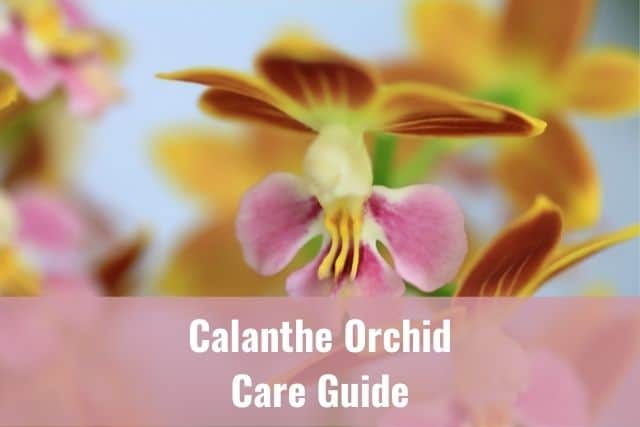
If you are new to Calanthe orchids, you’ve come to the right place. I’ll go over everything you need to know in order to care for your Calanthe orchid, from watering and lighting, to potting and propagation. Keep reading to learn more.
Please note that these links are affiliate links and as an Amazon Associate, I earn from qualifying purchases. Purchases made through affiliate links in this post may generate commissions at no additional cost to you. Use this link for a discounted Amazon Prime trial. Thank you for your support!
Table of Contents
Calanthe Orchids And Their Blooms
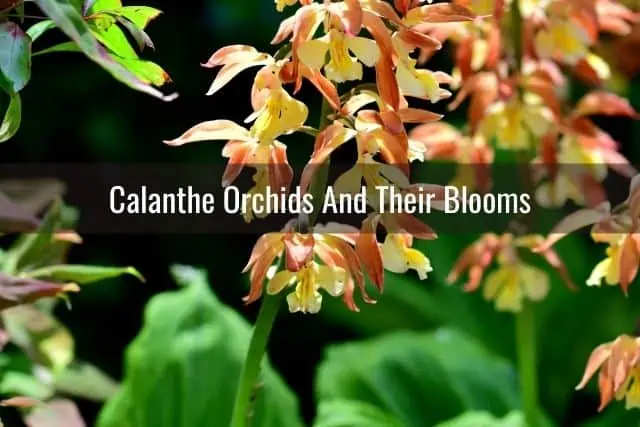
You may have heard of Calanthe orchids but may be wondering what they are and how to care for these orchids.
Calanthe orchids are a relatively small genus of orchids, native to Asia and Southeast Asia. In the wild, these orchids grow in the dappled shade of woodland forests and mountains. Keep this in mind if you are caring for them. You want to replicate as many aspects of their natural habitat as possible in order to optimize their growth and bloom production.
Calanthe orchids generally bloom during the cooler months, beginning in late fall through winter and early spring. Depending on the orchid species and variety, the blooms can last anywhere from several weeks to several months.
Most Calanthe orchids grow to be about 10 to 12 inches tall, making it an ideal orchid for your garden bed or as a border along the base of trees. Each spike produces dozens of small, colorful orchid blooms, creating a beautiful and stunning display each blooming season. The grassy green leaves of these orchids are pleated, wide and large.
Calanthe orchid flowers come in shades of brown, red, orange, yellow, white, and pink. Many of these flowers are actually bi-colored. This means that the blooms are a blend of more than one color, with the upper petals showcasing one color and the lower petals in another color.
The genus of Calanthe orchids can be divided into two types of plants: evergreen and deciduous. This is important to note and you want to be sure you know which Calanthe orchid variety you have. The growth patterns and some care needs will differ between evergreen and deciduous Calanthe orchids. I’ll outline the differences in each section below.
Evergreen Calanthe Orchids
Evergreen plants do not lose their leaves in the winter. These orchids continue to have foliage year-round. Examples of evergreen Calanthe orchids include the Calanthe hybrid Kojima Red, the Calanthe tricarinata AKA “Christmas orchid”, and the Calanthe Kozu Spice orchid.
Another notable difference is that evergreen Calanthe orchids have no pseudobulbs or very small pseudobulbs.
These orchids do well planted in a garden bed with other shade and partial-shade loving plants such as Lady Slipper orchids, ferns and hoya plants.
Deciduous Calanthe Orchids
Deciduous plants lose their leaves in the winter, and this is the case for the deciduous Calanthe orchid variety.
This particular type of Calanthe orchid is most commonly found in areas that have rainy periods during the spring and summers and dry fall and winters. Examples of deciduous Calanthe orchids include the Calanthe rozel, Calanthe rosea, and Calanthe cardioglossa.
Deciduous Calanthe orchids have large pseudobulbs, a feature that helps differentiate them from evergreen Calanthe orchids.
If you have a deciduous variety, you will notice that the leaves will turn yellow and fall off in the autumn or fall months. Feel free to prune off or remove old yellowing leaves.
Deciduous Calanthe orchids become dormant in the late fall and winter months. These orchids will need less watering during this time. Flower spikes typically emerge from the top of the pseudobulb.
Temperature Tolerance Of Calanthe Orchids

Calanthe orchids grow well in USDA plant zones 7 to 11, in temperatures ranging from 55 to 85 degrees Fahrenheit. Calanthe orchids can even survive in zone 6b, as long the ground does not freeze.
If you live in zone 6b and plan to leave your Calanthe orchid outdoors year-round, make sure you mulch heavily around your orchids with a thick layer of mulch. This will provide the roots with some extra protection from the cold. You can use a combination of fallen leaves and store-bought mulch to protect your orchids from the winter chill.
Be aware that these orchids do not like to be exposed to frost and should not be left outside in the winters if your area typically gets ice and snow during that time.
If this is the case for you, plant these orchids in a large pot and place a sturdy wheeled plant stand underneath the pot. This will allow you to easily transition your orchids indoors once temperatures start to drop in the fall.
Lighting Requirements

In terms of lighting, Calanthe orchids can tolerate shade conditions better than most other orchids. These orchids grow in shade to partial shade and do well with filtered light.
However, don’t interpret “shaded conditions” to mean poorly lit areas or parts of your garden that don’t get much light. On the contrary, Calanthe orchids need lots of bright, indirect light in order to thrive.
This can still be achieved under partially shaded conditions. You just want to avoid direct sunlight, as this can and will burn the delicate orchid leaves. Remember, these are cool-growing orchids.
Potting And Repotting Your Calanthe Orchid
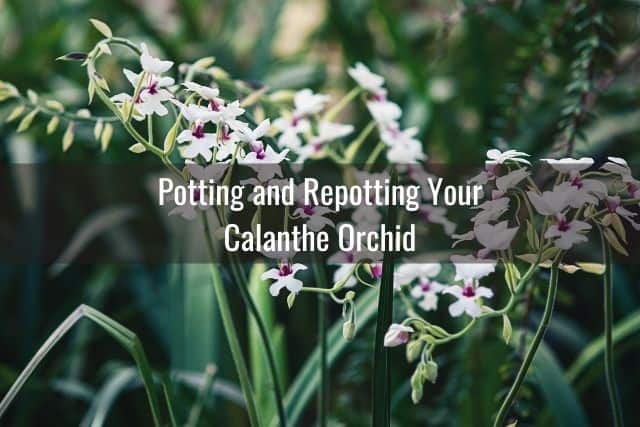
Calanthe orchids prefer moist, well-draining potting media. Plant these orchids in a mixture of fine-grade orchid potting media such as pine bark, peat moss or sphagnum moss, and organic matter.
For example, you can create a mixture that is rich in humus but still be well-draining. One option is to combine 2 parts organic material or compost mix with 2 parts orchid pine bark, 1 part sphagnum moss, and 1 part perlite. Some orchid growers also mix in some coconut coir, charcoal, or fast-draining succulent potting media.
You can create your own orchid potting mix to suit your orchids, climate and personal preference. The key is that the potting media needs to be well-draining and airy in order to prevent root rot. On the other hand, it still needs to retain enough moisture that the roots do not dry out.
Don’t use regular garden soil or potting soil, as this will be too heavy and “suffocate” your orchid’s roots. As mentioned above, these orchids can be planted outdoors as part of a garden bed or in a pot.
These orchids grow out laterally or to the sides, as most terrestrial orchids do. When planting or replanting/repotting your Calanthe orchid, allow room for the roots to spread out.
If you are growing your Calanthe orchid in a pot, point the newest growth towards the center of the pot to maximize the room for continued growth. When choosing an orchid pot, select a larger pot that is at least 12-inches in diameter.
If you are growing your orchid outdoors, choose a space in your garden that has ample room for the orchid to spread out as it grows each year. This is especially key if you want to avoid uprooting and replanting your orchid later on.
Fertilizing Your Calanthe Orchid
Fertilize your orchid with a balanced orchid fertilizer once every two weeks during the growing season, which is spring and summer. After the leaves begin to drop off in the fall and the orchid begins to enter its dormant period, stop fertilizing and decrease the watering frequency.
When fertilizing orchids, it is best to dilute your orchid fertilizer first. This will help you avoid problems such as yellow tips on the orchid leaves or root burn from over-fertilization. To learn more, read this guide on how to fertilize your orchids.
How To Water Your Calanthe Orchid
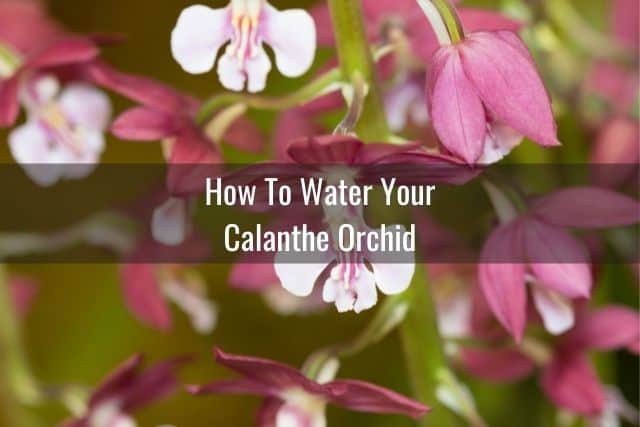
These orchids do best with regular watering to keep the potting media evenly moist. Watering frequency differs depending on whether you have an evergreen or deciduous Calanthe orchid. I’ll go into the different watering practices in more detail below.
Evergreen Calanthe Orchids
Evergreen Calanthe orchids, as mentioned above, do not lose their leaves in the fall or winter. One key care difference between the evergreen Calanthe and the deciduous Calanthe is that evergreen orchids need regular watering year-round.
Interestingly, these orchids can also be grown using a semi-hydroponic method using Leca clay pebbles if you want to try that out.
Deciduous Calanthe Orchids
Water your deciduous Calanthe orchid evenly during the spring and summer, and on into the fall, until you start to see the leaves begin to turn yellow. For deciduous Calanthe orchids, once the leaves begin to drop off, reduce your watering frequency. Allow the soil to dry out slightly between waterings.
These orchids will drop their leaves in the fall and enter into dormancy during the winter. During this time of dormancy, they can also survive occasional periods of drought and infrequent watering. You may notice that this is similar to many Dendrobium Nobile orchids, which need a winter rest and reduced watering as well.
Similar the watering schedule of Bletilla orchids, wait until you see new growth on your Calanthe orchid to water it. Watering the orchid too early may lead to root rot.
Once the orchid has new growth in the spring and summer, water evenly and regularly to keep the soil moist. Continue to water once you notice the top-layer of potting media is dry.
Watering Tips
When watering, make sure you avoid getting water in the the orchid’s crown, as this can lead to crown rot. In addition, water your orchids early in the morning. This will allow any excess water to drain away or dry up before nighttime.
Try to focus on watering the roots and avoid spraying the leaves with water. Once the orchid flower buds start to open, avoid getting water on the blooms, as this would otherwise cause spotting on the flowers. For more information, check out this guide on how to water your orchid.
Humidity Needs
These orchids prefer moderate humidity levels of around 50%, year-round. Proper humidity levels are key in the orchid’s continued growth and ability to produce blooms.
If you aren’t sure of what your area’s outdoor humidity levels are, you can invest in an outdoor hygrometer. Place this in a location close to your orchid’s growing area to get an idea of whether it has adequate humidity or not.
If your orchids are outdoors year-round, you can invest in an outdoor water fountain or a water feature and place it near your orchids. If you have a lot of room, you can even build a small pond and plant Calanthe orchids along the edge of the water. Big or small, any water feature or fountain will help increase humidity levels in the area immediately surrounding it.
Indoor orchids can use humidifiers and humidity trays to help improve indoor humidity levels. For more ideas, check out my other Everyday Orchids article on how to increase humidity levels for indoor orchids.
Unlike watering frequency which can change depending on the season, the humidity requirements are always 50% humidity. This remains the same whether you have an evergreen or deciduous Calanthe orchid. Maintain even humidity levels at or around 50% year-round for a healthy, happy Calanthe orchid.
Propagating And Dividing Your Calanthe Orchid

Calanthe orchids can be propagated by pseudobulb division. This is best done in the spring, after the orchid has finished blooming and new growth is starting to show.
To divide your Calanthe orchid, gently remove it from the potting media. If it is in the ground, carefully dig it up and try not to damage the roots. I like to give my orchid a wide berth when digging. Clean the roots and wash off all the old potting media.
The next step is to carefully separate the pseudobulbs from each other. Deciduous Calanthe pseudobulbs tend to be more delicate. The top part of the pseudobulb can break off easily if you aren’t careful. You can either gently tug the pseudobulbs apart or use a sterilized knife to separate them.
Once the pseudobulbs are separated, you can let them sit overnight to allow the cut areas to dry. Alternatively, you can apply a rooting hormone to the cut area and around the roots. Then, repot or plant the pseudobulbs immediately. I usually opt to do this.
You can plant 1 or 2 pseudobulbs per pot, depending on the orchid pot size. Place the pseudobulb roots-down into the pot.
Use a larger ratio of organic potting media to cover the roots initially. Then, use faster-draining media such as bark chips, coconut husks, and perlite to surround the base of the pseudobulb. This will help prevent pseudobulb rot. Don’t bury the pseudobulb or bury any new growth.
Wait until you see new growth start to emerge before you begin watering your orchid pseudobulb. Watering before this happens increases the risk for rot. When you see new growth, you can slowly start to water your orchid. Be careful not to allow water to settle in the crown of the new growth.
Pests And Diseases
Fortunately (or unfortunately), orchid pests are the biggest concern for Calanthe orchids. These orchids are relatively hardy and are not prone to diseases.
However, spider mites, slugs and snails are common orchid pests that you’ll need to watch out for.
Spider Mites
Spider mites can multiply quickly and spread easily among plants, so early detection is key.
Regularly inspect your plants and check under the orchid leaves for spider mite webbing. This can be seen as a silvery white web or “film” on the underside of orchid leaves.
If you notice that your orchid has the beginnings of a spider mite infestation, read this guide on how to get rid of spider mites for more information on what you need to do.
Slugs And Snails
Slugs and snails can destroy the young shoots and new growth in the spring. Take steps to prevent this. You can sprinkle slug and snail killer around your garden, near the base of the orchid, to help repel these pests.
Final Thoughts
Calanthe orchids are beautiful outdoor orchids that can add a pop of color to your shade garden. If you have the evergreen variety, your garden will remain green year-round.
These orchids are versatile, as they can be grown outdoors year-round or grown in a pot. They can be propagated easily and are relatively easy to care for.
Enjoy your new Calanthe orchid, and I hope this care guide has helped you know how to care for your plant. As always, happy orchid growing!
If you enjoyed this article, please pin it and share!
